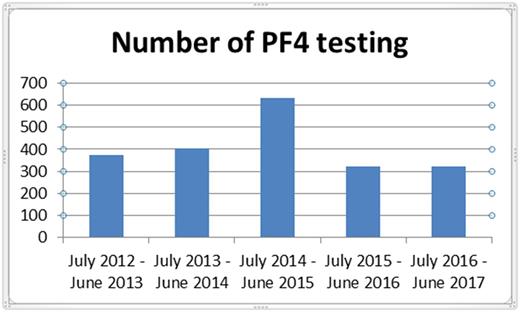Abstract
Systems-based hematologists (SBH) play a vital role in navigating the health care system in the use of diagnostic tests that crosses multiple disciplines by implementing evidence-based strategies to improve patient safety and outcomes. In 2013, we demonstrated that an Anticoagulation and Bleeding Management Service (ABS) led by SBH played a major role in developing safe and cost-effective approaches for the diagnosis of patients with heparin-induced thrombocytopenia (HIT) via implementation of a centralized hospital-wide physician paper order protocol (Vaughn et al. Blood. Vol. 124, Abstract 4848). Platelet factor 4 (PF4) ELISA testing decreased from 600 in 2011 to 375 in 2013 (37.5% decrease), and serotonin release assay (SRA) testing decreased from 202 in 2011 to 29 in 2013 (85% decrease). In addition, 100% of patients with positive PF4 ELISA received an automatic consult by the ABS team to determine management of patients with suspected HIT. This led to a reduction in the use of direct thrombin inhibitors (DTI) by 78%. Despite this initial success, we were unsure if these improvements were sustainable moving forward.
The purpose of this study was to provide quantitative data demonstrating the continuous impact that SBH have on health care delivery via annual re-auditing on PF4 ELISA testing to identify shortfalls and implement improvements as needed. In 2014, our institution switched to a new electronic medical record (EMR) system using EPIC in the inpatient environment. The 4T's Scoring Calculator physician paper order became obsolete. An electronic order set for PF4 ELISA test was in discussion but due to the complexity of switching to a new EMR system, this discussion was stalled. Now, physicians could order a PF4 ELISA test electronically without a 4T score. As a result, PF4 ELISA testing increased to 402 in 2014 and 632 in 2015. Ordering of SRA test, which was restricted to the ABS team, remained constant at 31 in 2014 and 36 in 2015.
To overcome this, throughout 2015-2016, the ABS team gave specific feedback to the ordering physician when a false-positive PF4 ELISA test was ordered inappropriately. This allowed for individual discussion on each patient case to improve physicians' understanding and awareness of HIT testing and management. In addition, departmental-wide lectures on HIT/4T score to attending physicians and residents/fellows were scheduled.
Despite these departmental-wide lectures, the ABS team found that ordering physicians remained unclear about calculation of the 4T score. Ordering physicians were calculating higher 4T scores and ordering PF4 ELISA based on their calculations. As a result, specific interactive lectures based on real-life case scenarios where the audience (internal medicine residents) calculated the 4T score for each scenario were given. This allowed for case-based discussions and opportunity for clarifying any uncertainty on the 4T score. Feedback from the residents was overwhelmingly positive. These efforts led to a reduction in PF4 ELISA test by 49% to 323 in 2016. A re-audit revealed that the number of PF4 ELISA test remained steady at 321 in 2017, which demonstrates the success of our interventions (Figure 1).
In conclusion, this study highlights the important of re-auditing to maintain the improvements made. Despite initial success, annual re-auditing allowed for early detection of challenges, which then allowed appropriate early intervention. Administrative and financial support from the health care system for SBH allowed for the initiation, implementation and monitoring of this HIT program, and should be encouraged nationwide as a rewarding career opportunity for hematologists interested in hospital quality improvement and patient safety.
No relevant conflicts of interest to declare.
Author notes
Asterisk with author names denotes non-ASH members.


